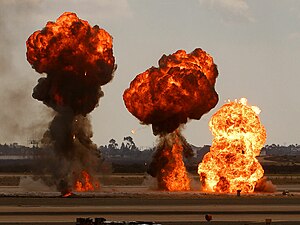Deflagration

Deflagration (Lat: de + flagrare, 'to burn down') is subsonic combustion in which a pre-mixed flame propagates through an explosive or a mixture of fuel and oxidizer.[1][2] Deflagrations in high and low explosives or fuel–oxidizer mixtures may transition to a detonation depending upon confinement and other factors.[3][4] Most fires found in daily life are diffusion flames. Deflagrations with flame speeds in the range of 1 m/s differ from detonations which propagate supersonically with detonation velocities in the range of km/s.[5]
Applications
Deflagrations are often used in engineering applications when the force of the expanding gas is used to move an object such as a projectile down a barrel, or a piston in an internal combustion engine. Deflagration systems and products can also be used in mining, demolition and stone quarrying via gas pressure blasting as a beneficial alternative to high explosives.
Terminology of explosive safety
When studying or discussing explosive safety, or the safety of systems containing explosives, the terms deflagration, detonation and deflagration-to-detonation transition (commonly referred to as DDT) must be understood and used appropriately to convey relevant information. As explained above, a deflagration is a subsonic reaction, whereas a detonation is a supersonic (greater than the sound speed of the material) reaction. Distinguishing between a deflagration or a detonation can be difficult to impossible to the casual observer. Rather, confidently differentiating between the two requires instrumentation and diagnostics to ascertain reaction speed in the affected material. Therefore, when an unexpected event or an accident occurs with an explosive material or an explosive-containing system it is usually impossible to know whether the explosive deflagrated or detonated as both can appear as very violent, energetic reactions. Therefore, the energetic materials community coined the term "high explosive violent reaction" or "HEVR" to describe a violent reaction that, because it lacked diagnostics to measure sound-speed, could have been either a deflagration or a detonation. [6][7]
Flame physics
The underlying flame physics can be understood with the help of an idealized model consisting of a uniform one-dimensional tube of unburnt and burned gaseous fuel, separated by a thin transitional region of width in which the burning occurs. The burning region is commonly referred to as the flame or flame front. In equilibrium, thermal diffusion across the flame front is balanced by the heat supplied by burning.[8][9][10][11]
Two characteristic timescales are important here. The first is the thermal diffusion timescale , which is approximately equal to
where is the thermal diffusivity. The second is the burning timescale that strongly decreases with temperature, typically as
where is the activation barrier for the burning reaction and is the temperature developed as the result of burning; the value of this so-called "flame temperature" can be determined from the laws of thermodynamics.
For a stationary moving deflagration front, these two timescales must be equal: the heat generated by burning is equal to the heat carried away by heat transfer. This makes it possible to calculate the characteristic width of the flame front:
thus
Now, the thermal flame front propagates at a characteristic speed , which is simply equal to the flame width divided by the burn time:
This simplified model neglects the change of temperature and thus the burning rate across the deflagration front. This model also neglects the possible influence of turbulence. As a result, this derivation gives only the laminar flame speed—hence the designation .
Damaging events
Damage to buildings, equipment and people can result from a large-scale, short-duration deflagration. The potential damage is primarily a function of the total amount of fuel burned in the event (total energy available), the maximum reaction velocity that is achieved, and the manner in which the expansion of the combustion gases is contained. Vented deflagrations tend to be less violent or damaging than contained deflagrations.[12]
In free-air deflagrations, there is a continuous variation in deflagration effects relative to the maximum flame velocity. When flame velocities are low, the effect of a deflagration is to release heat, such as in a flash fire. At flame velocities near the speed of sound, the energy released is in the form of pressure, and the resulting high pressure can damage equipment and buildings.[13]
See also
References
- ^ O'Conner, Brian (March 27, 2023). "Explosions, Deflagrations and Detonations". National Fire Protection Association. Archived from the original on March 28, 2023. Retrieved May 31, 2023.
- ^ Handbook of Fire Protection Engineering (5 ed.). Society of Fire Protection Engineers. 2016. p. 373.
- ^ McDonough, Gordon (April 1, 2017). "What is a high explosive". Bradbury Science Museum, Los Alamos National Laboratory. Archived from the original on 2017-05-02. Retrieved May 31, 2023.
- ^ Rosas, Camilo; Davis, Scott; Engel, Derek; Middha, Prankul; van Wingerden, Kees; Mannan, M.S. (July 2014). "Deflagration to detonation transitions (DDTs): Predicting DDTs in hydrocarbon explosions". Journal of Loss Prevention in the Process Industries. 30: 263–274. Bibcode:2014JLPPI..30..263R. doi:10.1016/j.jlp.2014.03.003. Retrieved May 31, 2023.
- ^ Handbook of Fire Protection Engineering (5 ed.). Society of Fire Protection Engineers. 2016. p. 390.
- ^ Squires, Jess (2023-01-22). "High Explosive Violent Reaction (HEVR) — DOE Directives, Guidance, and Delegations". www.directives.doe.gov. Archived from the original on 2022-09-29. Retrieved 2023-06-08.
- ^ "What's the difference between an explosion and a detonation?". www.lanl.gov. Retrieved 2023-06-08.
- ^ Williams, F. A. (2018). Combustion theory. CRC Press.
- ^ Landau, L. D., & Lifshitz, E. M. (1959). Fluid Mechanics. Course of Theoretical Physics, 6.
- ^ Linan, A., & Williams, F. A. (1993). Fundamental aspects of combustion.
- ^ Zeldovich, I. A., Barenblatt, G. I., Librovich, V. B., & Makhviladze, G. M. (1985). Mathematical theory of combustion and explosions.
- ^ Tarver, C. M.; Chidester, S. K. (2004-02-09). "On the Violence of High Explosive Reactions". Journal of Pressure Vessel Technology. 127: 39–48. doi:10.1115/1.1845474. OSTI 15013892.
- ^ NFPA 68 Standard on Explosion Protection by Deflagration Venting. National Fire Protection Association. 2018. p. 5.






![{\displaystyle \tau _{b}\propto \exp[\Delta U/(k_{B}T_{f})],}](https://wikimedia.org/api/rest_v1/media/math/render/svg/dc7767dfdc693834aa5192529439f926e52aeea1)






